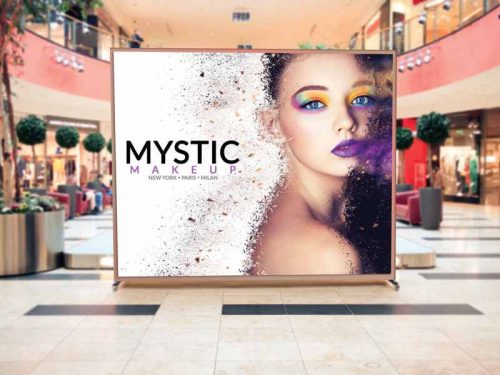Working with the best

Since POP displays are changed frequently, print providers need fabric they can rely on time and again that provide excellent imaging detail and brilliant colour.
The best quality backlit fabrics have coatings that provide a consistent white point from roll to roll and batch to batch, which eliminates the need to re-profile for colour consistency. These coatings are ink-receptive as well as ink-diffusing and also prevent ‘hot spots’ and ‘pinholes’ where light from light-emitting diode (LED) backlit systems shine through, detracting from the finished graphic. These fabrics are typically processed through a heat calendar at much higher temperatures and extended dwell times, so the ink penetrates the coatings and deposits into dye sites in the fibres, providing optimum print penetration and colour.
Today, print providers (and customers) have become very savvy when choosing fabrics for backlit displays, especially when it comes to the look and feel of the installation. Therefore, it is important for PSPs to consult with their fabric vendors regarding proper printing methods for each fabric type and its application.
Retractable banner stands and double-sided printed graphics are also popular applications for POP marketing—from sidewalks to in-store displays. For retractable banner stands, print providers need to choose a fabric that is very stable and structurally rigid on the sides, so it rolls properly without curling. The fabric should be heavyweight and must have an acrylic black or white back coating to eliminate light from shining through the graphic. Double-sided banners are printed on fabrics with white layers on each side and a black layer in the middle, which allows PSPs to print a different image on each side without light glaring through the finished graphic.
Window graphics are a popular application since they are designed to draw customers into retail stores with eye-catching images. These types of graphics are often installed in frontlit SEG frames or banners sewn with pole loops at the top and bottom of the image to keep the finished prints tight and wrinkle-free. Fabrics used for window displays should have stable dimensional stretch, optic white finish, and a tight-knit or woven construction to block light from behind the graphic.
Fabric graphics are ideal for short-term marketing campaigns as well, due to speed to market and quick turnaround times. Print providers can queue up graphics for multiple campaigns and make quick adjustments within digital design files. Due to their light weight, these prints can easily be shipped to multiple locations.
Consistency guarantees success
POP graphics production has seen tremendous growth in the past few years, which is driven by constant changes in retail seasons and promotions as brands seek to sell in-store inventory. Retail owners typically install the same size and type of frames across multiple locations. For print providers, this can mean hundreds, if not thousands, of printed fabric graphics with repeat business on a regular basis. Choosing the right fabric for applications and providing brilliant images can capture recurring revenue streams. Therefore, it is critical to use fabrics that are consistent with applications. Recording and storing precise measurements for frontlit and backlit frame systems as well as properly profiling each fabric for its intended use can also ensure a company’s success.
Michael Compton is the print media product marketing manager for Top Value Fabrics (TVF), a graduate of Purdue University, and an industry veteran. He has experienced the dynamics of digital textile printing throughout its history and has
a wealth of knowledge in the field. His expertise proves helpful both to customers who are learning the technology and to those with advanced capabilities. With a proven track record of 20 years working in all aspects of digital printing on textiles globally, Compton enjoys new challenges and collaborating with clients to identify innovative solutions for specific needs. He appreciates the progressive nature of the graphics sector and the opportunity to share developments within the industry. Compton has served as chairman of the Specialty Graphic Imaging Association’s (SGIA’s) Sustainability, Health, Safety, and Personnel Advisory Council and as vice-chairman of the Industrial Fabrics Association International’s (IFAI’s) Fabric Graphics Association Advisory Board. He can be reached via e-mail at
michaelcompton@tvfinc.com.





